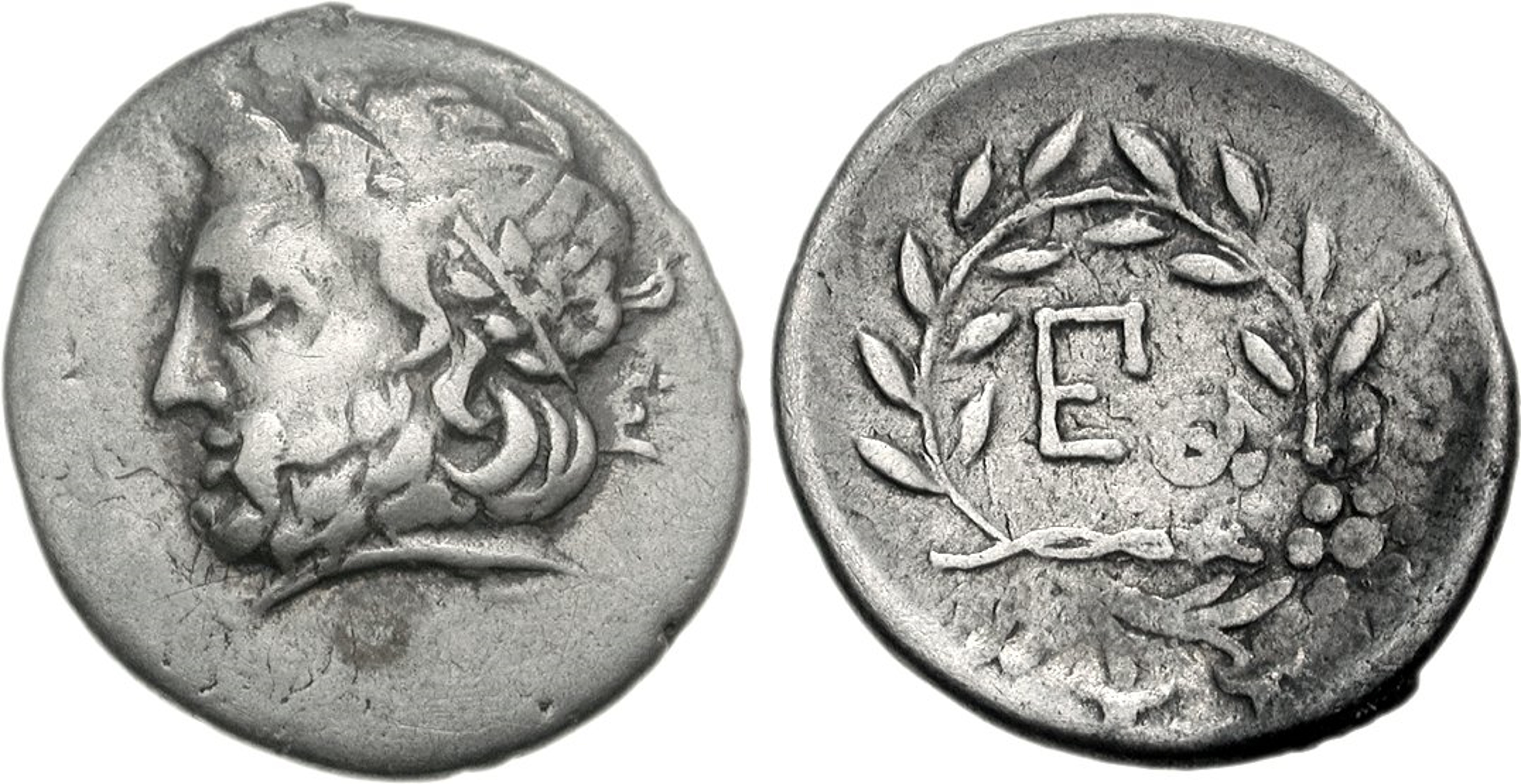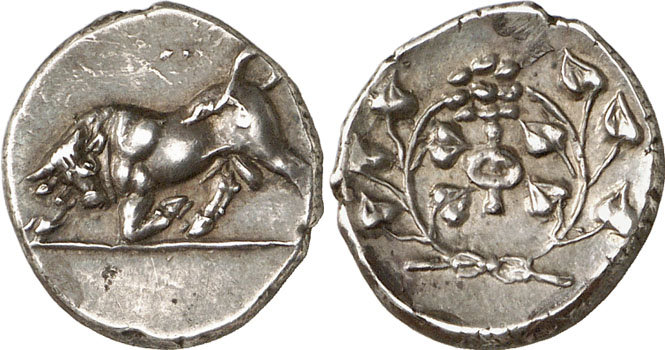2999 - Epidaurus (hemidrachm Asclepius/monogram) over Phlius (bull/phi) (CNG, MBS 81, May 2009, 2493): Difference between revisions
From SILVER
No edit summary |
|||
| Line 17: | Line 17: | ||
|Metal=Silver | |Metal=Silver | ||
|Weight=2.7 | |Weight=2.7 | ||
|Axis=7 | |Axis=7 | ||
|Denomination= | |Denomination=hemidrachm | ||
|Standard=Aeginetic | |Standard=Aeginetic | ||
|Coin reference=Requier 1993, series 2, dies D1/R1, 169). | |Coin reference=Requier 1993, series 2, dies D1/R1, 169). | ||
Revision as of 20:44, 17 November 2023
250 - 240 | monogram (EΠ)
Location/history
| Sale(s)Sale(s) ᵖ: | Classical Numismatic Group MBS 81 (20/05/2009), no. 2493. | ||
| Private collection(s)Private collection(s) ᵖ: | BCD collection | Archaeological contextArchaeological context: | 1979/80 Epidaurus Hoard (CH VII, 69) |
Overstriking coin
Description
| ObverseInscription or printing placed on the obverse.: | Head of Asclepius left, wearing laurel wreath. In field, E. | ReverseInscription or printing placed on the reverse.: | monogram (EΠ) (Greek) Monogram within laurel wreath. |
Mint and issuing power
| MintIdentifies the place of manufacture or issue of a numismatic object.: | Epidaurus | Ancient regionAncient region. | Peloponnesus (Argolis) | Modern countryModern country: Greece | AuthorityIdentifies the issuing power. The authority can be "pretended" when the name or the portrait of X is on the coin but he/she was not the issuing power. It can also be "uncertain" when there is no mention of X on the coin but he/she was the issuing power according to the historical sources: |
Chronology
| FromIdentifies the initial date in a range assigned in a numismatic context. 250 toIdentifies the final date in a range assigned in a numismatic context.. 240 | Hellenistic 323-30 BC |
Physical description
| MetalThe physical material (usually metal) from which an object is made.: Silver |
WeightWeight of the numismatic object (in grams). in grams: 2.72.7 g <br />2,700 mg <br /> | DenominationTerm indicating the value of a numismatic object. Examples: tetradrachm, chalkous, denarius.: hemidrachm |
AxisDescribes the directional relationship between the obverse and reverse of a numismatic object.: 77 mm <br />0.7 cm <br /> |
| StandardStandard.: Aeginetic | |||
References
| Coin referenceReference of the Coin: | Requier 1993, series 2, dies D1/R1, 169). | Coin series referenceReference to coin series study: | LHS 96 20061LHS 96 2006, no. 1237-1239 (same dies) and 1241, HGC 52HGC 5, n° 724 |
Overstruck type
Description
| ObverseInscription or printing placed on the obverse.: | ReverseInscription or printing placed on the reverse.: | Φ Φ within wreath. |
Mint and issuing power
| MintIdentifies the place of manufacture or issue of a numismatic object. ᵖ: | Phlius | Ancient regionAncient region. ᵖ | Peloponnesus (Phliasia) | Modern countryModern country: Greece | AuthorityIdentifies the authority in whose name (explicitly or implicitly) a numismatic object was issued. ᵖ: |
Chronology
| FromIdentifies the initial date in a range assigned in a numismatic context. 280 toIdentifies the final date in a range assigned in a numismatic context.. 270 | Hellenistic 323-30 BC |
Physical description
| DenominationTerm indicating the value of a numismatic object. Examples: tetradrachm, chalkous, denarius. ᵖ: | hemidrachm |
References
| Coin type referenceReference to coin series study ᵖ: | LHS 96 20061LHS 96 2006, no. 132ff |
Additional data
| Frequency of overstrikesFrequency of overstrikes: | frequent | Level of confidenceLevel of confidence of the identification: | sure |
| RemarksRemarks: | Overstruck on a hemidrachm of Phlious (cf. BCD Peloponnesos 132ff). | ||

